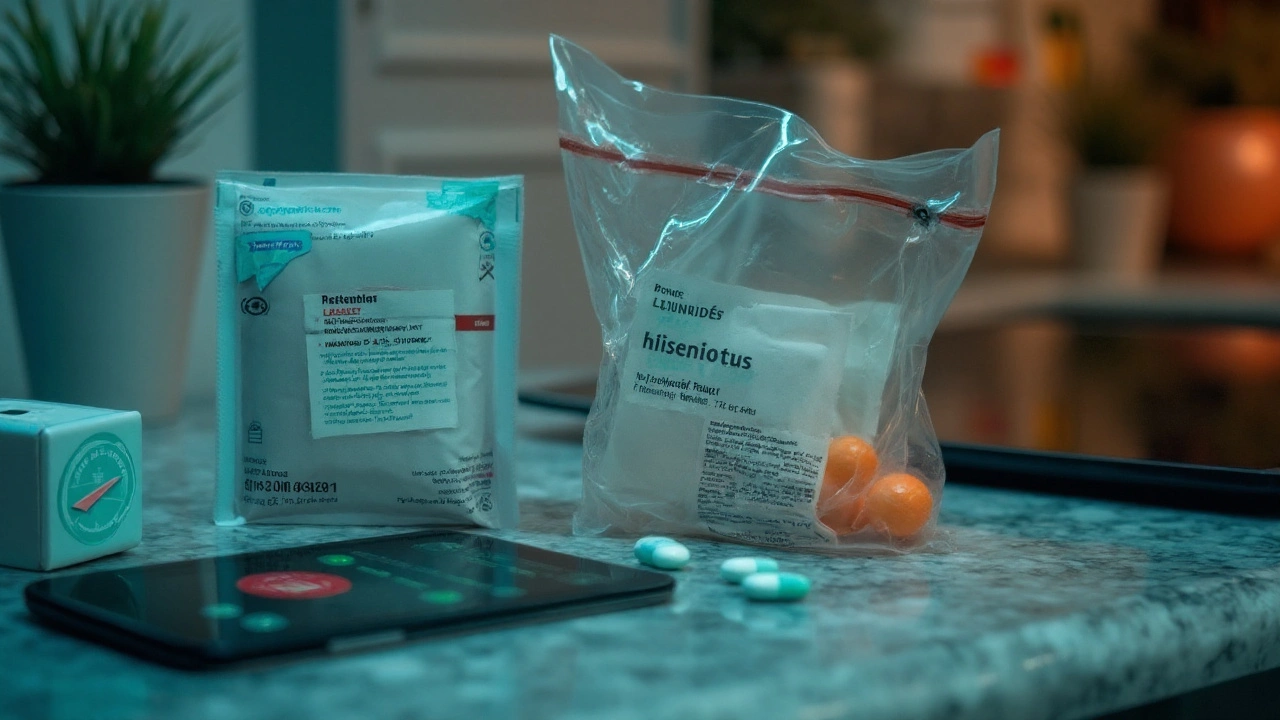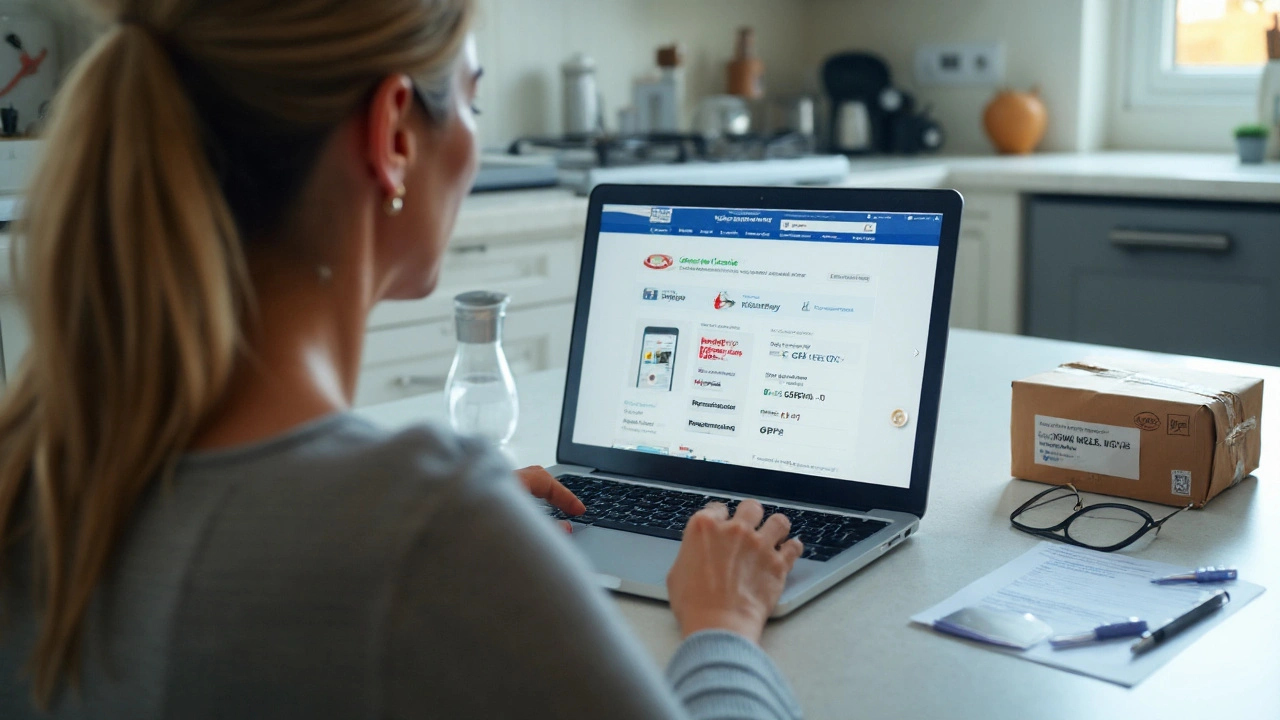You came here to save money and time on furosemide (Lasix) without getting burned by sketchy online pharmacies. Here’s the straight answer: in the UK, you can buy generic furosemide online safely and cheaply-but only from a registered pharmacy, and you’ll still need a valid prescription. Expect medicine prices that are a few pounds, plus a consultation or private prescription fee if you don’t already have one. I’m in Birmingham, and I’ve seen how easy it is to click the wrong site when you’re rushing between work and walking Bailey, my cocker spaniel. So this guide keeps it tight: what’s legal, how to verify a real pharmacy, what “cheap” looks like in 2025, the health risks to respect, and a step-by-step you can follow today.
What you can (and can’t) do when buying furosemide online in the UK
Lasix is the brand name for furosemide, a loop diuretic used for fluid build-up in conditions like heart failure, liver disease, and kidney disease. It’s prescription-only in the UK. That means any website that ships it without checking a prescription is breaking UK law and putting you at risk.
Here’s what’s allowed-and smart-to do:
- Order furosemide from a UK-registered online pharmacy that either: a) accepts your NHS/electronic prescription, or b) offers a safe online consultation with a prescriber who decides if it’s appropriate.
- Choose generic furosemide instead of the brand Lasix. In the UK, generics are standard, equivalent, and cheaper.
- Use NHS prescriptions where possible. In England, you pay a fixed charge per item unless exempt. In Scotland, Wales, and Northern Ireland, prescriptions are free.
- Ask your GP or heart failure clinic to issue repeat prescriptions via your chosen pharmacy for smoother refills.
And here’s what not to do:
- Don’t buy from sites offering “no prescription needed” or “doctor-free” Lasix. That’s illegal and unsafe.
- Skip any online shop that hides its physical address, pharmacist details, or registration number.
- Don’t use furosemide for weight loss. It sheds water, not fat, and can cause dangerous electrolyte shifts.
Why the caution? Regulators regularly seize large volumes of illegal medicines sold online during international operations. Counterfeits may contain the wrong dose-or the wrong drug. For medical facts, check the NHS medicines page for furosemide; for professional guidance, the BNF/NICE monographs are the UK standard; for patient safety, UK regulators include the MHRA and GPhC.
How to verify a safe UK online pharmacy (fast checks and red flags)
Two minutes of checking can save you weeks of headaches. Use this quick checklist:
- GPhC registration: Look for the pharmacy’s GPhC number and verify it on the General Pharmaceutical Council online register.
- Real UK address: There should be a physical premises in the UK, not just a PO box.
- Superintendent pharmacist: A named, registrant pharmacist is a good sign.
- Prescription policy: They should ask for an NHS prescription upload or provide an online consultation reviewed by a UK prescriber.
- Contact options: Clear phone/email and pharmacy opening hours. Responsive support is a basic safety net.
- Transparent pricing: Medicine price, consultation/prescription fee, and delivery cost shown upfront before checkout.
- Data security: Secure payment (look for “https” and known payment processors) and a UK privacy policy.
Red flags to walk away from:
- “No prescription required” for a prescription-only medicine.
- Prices that are wildly lower than UK norms (often a counterfeit signal).
- No pharmacist name, no UK address, or vague company details.
- No medical questions before selling you a POM (prescription-only medicine).
- Pressure tactics like countdown timers on medicines.
One more tip: after Brexit, the old EU “distance-selling logo” isn’t the UK indicator to rely on. In 2025, the safer bet is verifying the pharmacy and pharmacist on the GPhC register and ensuring the prescriber is GMC-registered if the site offers private prescriptions.

What “cheap” actually looks like in 2025: pricing, fees, and ways to save
Generic furosemide is inexpensive. The medicine itself usually costs only a few pounds per 28 tablets. The bigger swing is fees and delivery. Here’s what to expect in the UK this year:
| Cost component | Typical 2025 range | What to know |
|---|---|---|
| Furosemide tablets (20 mg or 40 mg), 28-pack | £2-£8 | Generic prices vary slightly by strength and brand; 40 mg often similar to 20 mg. |
| Private prescription/consultation | £5-£25 | If you don’t have an NHS prescription, an online prescriber may charge a review/issue fee. |
| Delivery (tracked 24-48h) | £0-£5 | Some pharmacies offer free delivery above a minimum spend or for repeat plans. |
| Total typical private order | £12-£25 | All-in, depending on the site’s fees and delivery options. |
| NHS prescription charge (England) | ~£9.90 per item | Check the current year’s rate; many people qualify for exemptions. |
| NHS prescription (Scotland, Wales, NI) | £0 | Prescriptions are free if issued within these nations. |
Bottom line on price: with an NHS prescription, you usually pay the fixed charge (or nothing if exempt or outside England). With a private online consultation, the medicine is cheap but the service fees make the total more like £12-£25 for a month’s supply. If you take multiple medicines, a prepayment certificate (PPC) in England can cut costs sharply if you pay NHS charges regularly.
Quick savings tips that actually work:
- Use your existing NHS prescription whenever possible. Ask your GP to send it electronically to your chosen online pharmacy.
- Choose generic furosemide from any reputable manufacturer; clinical effect is equivalent to brand (NHS and BNF confirm this).
- Order 2-3 months at a time if your prescriber is happy with that. You’ll pay delivery once and cut faff.
- Pick slower delivery when you can; it’s often free or cheaper and still arrives in 2-3 days.
- If you pay the NHS charge often, look into a 3‑month or 12‑month PPC to spread costs.
Safety first: who should and shouldn’t use furosemide, side effects, and interactions
Even when you’re chasing a bargain, your safety comes first. Furosemide can shift fluids and electrolytes quickly. Used right, it helps breathlessness and swelling. Used wrong, it can leave you dehydrated and dizzy.
Who typically uses furosemide:
- Adults with fluid overload from heart failure, kidney disease, or liver disease.
- Sometimes used in resistant oedema when other diuretics aren’t enough.
Who should check carefully with a clinician before using or continuing:
- People with low blood pressure, severe dehydration, or acute kidney injury.
- Those with very low potassium or sodium.
- People on lithium, digoxin, or high-dose NSAIDs-interactions can be serious.
- Pregnant or breastfeeding people-only use if a clinician says the benefits outweigh risks.
- History of sulfonamide allergy-cross-reactivity is uncommon but still discuss it.
Common side effects:
- Frequent urination (that’s the point), thirst, dry mouth.
- Lightheadedness, especially when standing.
- Low potassium or sodium, cramps, fatigue.
Serious issues-call for help urgently if you notice:
- Severe dizziness or fainting.
- Muscle weakness, confusion, or palpitations (possible electrolyte imbalance).
- Hearing changes (rare but reported with high doses/IV).
- Rash or swelling of face/lips (allergic reaction).
Interaction watch-outs (check the patient leaflet and talk to your pharmacist or prescriber):
- ACE inhibitors/ARBs (like ramipril, losartan): blood pressure may drop too much when combined; sometimes doses are adjusted carefully.
- NSAIDs (ibuprofen, naproxen): can blunt the diuretic effect and stress the kidneys.
- Lithium: furosemide can raise lithium levels; often avoided or monitored closely.
- Digoxin: low potassium increases digoxin toxicity risk; potassium monitoring matters.
Practical tip from real life: time your dose. If you take furosemide late afternoon, you may be up all night. I plan doses so Bailey’s evening walk isn’t interrupted by me hunting for a loo. Most people take it in the morning; if you’re on twice-daily dosing, ask your prescriber about late-afternoon timing to avoid night-time trips.
Reliable sources to back all this: NHS medicines guidance for furosemide, the British National Formulary (BNF), NICE clinical advice on diuretic use, and the official Summary of Product Characteristics (SmPC) from the manufacturer. Your own clinic’s plan always comes first.

Step-by-step: the safest way to order today, plus FAQs and next steps
Use this decision path and you’ll avoid 99% of the pitfalls.
- Confirm you need furosemide now. Are you on a repeat? Any new symptoms like severe dizziness, cramps, or sudden weight changes? If yes, message your GP or heart team first.
- Choose how you’ll get the prescription:
- If you have an NHS prescription: ask your GP to send it electronically to a registered online pharmacy of your choice.
- If you don’t: pick a UK online pharmacy that offers a proper questionnaire reviewed by a UK prescriber. Expect a small fee.
- Verify the pharmacy:
- Check GPhC registration and UK address.
- Make sure prescribers are named and GMC-registered if it’s a private issue.
- Read a few recent, specific reviews-do they mention real delivery times and support?
- Compare the true total price:
- Medicine price + prescription/consultation fee + delivery = your real cost.
- Don’t chase the absolute cheapest unit price if the fees and delivery wipe out the saving.
- Order thoughtfully:
- Stick to your usual strength (often 20 mg or 40 mg). If unsure, check your last box or GP app.
- Order a sensible quantity (often 28 or 56 tablets) to reduce delivery charges.
- Pick standard delivery unless you need it next-day.
- On delivery day:
- Check the pack: strength, your name, batch number, expiry date, patient leaflet inside.
- If the tablets look different from your usual, that’s fine with generics-just cross-check the strength on the label.
- Start or continue safely:
- Take it the way your prescriber told you. Don’t self-escalate “to dry out faster”.
- Weigh yourself at the same time daily if you’re in a heart failure plan; log big changes and call if needed.
- Keep an eye on blood pressure and electrolytes as advised; your clinic may set regular blood tests.
Quick compare: online vs local pharmacy
- Online wins for convenience, private prescriptions, and repeat delivery to your door.
- Local wins for same-day pickup and face-to-face advice-handy if you’re short today.
Best fits:
- Online is best for stable repeat users who know their dose and like home delivery.
- In-person is best if you’re starting therapy, unwell, dizzy, or have new swelling-speak to a clinician.
FAQs
- Can I buy generic lasix online without a prescription? No. In the UK it’s illegal to sell furosemide without a prescription. Stick to registered pharmacies that verify a script or provide a proper consultation.
- Is generic furosemide as good as Lasix? Yes. UK generics must meet the same quality standards and bioequivalence requirements. NHS and BNF treat them as clinically interchangeable.
- What’s a normal dose? Doses vary widely by condition and response. Many adults start at 20-40 mg once daily, adjusted by a clinician. Don’t change dose without advice.
- Do I need blood tests? Often yes-especially potassium, sodium, and kidney function. Frequency depends on your condition and stability.
- What if I miss a dose? If it’s late in the day, many people skip and take the next dose at the usual time to avoid being up all night. Ask your pharmacist for personalised advice.
Troubleshooting and next steps
- If you need it urgently today: call your local pharmacy to see if they can dispense from an NHS e‑prescription the same day, or contact your GP/111 for advice on bridging supplies.
- If the online site rejects your order: answer medical questions carefully and honestly; you may need recent clinic notes or blood test results for safe prescribing.
- If you feel lightheaded on your usual dose: check your weight, blood pressure if you can, sip fluids, and contact your clinic. Don’t stack extra doses.
- If cost is the main blocker: ask your GP about repeat dispensing, check NHS charge exemptions, or get a Prescription Prepayment Certificate in England. Private online fees often cost more than NHS routes.
- If your tablets look different: generic suppliers change, shapes/colours vary. Confirm the strength on the label and the active ingredient “furosemide.” When in doubt, message the pharmacy.
- If you’re traveling: order a fresh supply 1-2 weeks before you go, keep meds in original packaging, and set dosing around your destination time zone to avoid night-time diuresis.
Final thought: a “cheap” buy isn’t cheap if it risks your health. Stick to UK-registered pharmacies, keep your prescriber in the loop, and use the price rules here to avoid surprise fees. Once you’ve got a safe setup-script, trusted pharmacy, and a delivery rhythm-you’ll spend less money, less time, and have fewer midnight dashes to the bathroom.





Mithun Paul
August 22, 2025 AT 01:34Don't skip checking the GPhC number - that's the single quickest sanity check when a site claims to be a UK pharmacy.
Look up the number on the GPhC register and confirm the address matches the site. If the superintendent pharmacist is named and present on the register, that adds a real layer of legitimacy. Sites that hide or omit those details are doing the exact opposite of due diligence and should be ignored. Also, keep an eye on the prescription workflow: any site that accepts orders without insisting on a clear prescription path is operating outside expected practice. Keep receipts and screenshots of any consultation notes in case you need to dispute a charge or verify instructions later. Finally, treat freebies and absurdly low prices as a flag rather than a bargain.
Sandy Martin
August 24, 2025 AT 08:57Nice plain talk about the prescription rules, that helps a lot for people who get overwhelmed.
One small thing i see often is folks not realising the NHS e‑prescription flow can be sent directly to an online pharmacy, which beats uploading photos of old scripts. If you use the e‑prescription route it saves a ton of back and forth and reduces the chance of a dodgy supplier slipping in. Also, keep a note of the consultation fee so you can compare apples to apples when ordering.
Josie McManus
August 26, 2025 AT 16:20Solid practical tips on timing doses and avoiding nighttime diuresis, that one actually matters.
People trying to use furosemide for quick weight loss need to read the electrolyte section several times and then stop. This is not a cosmetic shortcut and the risks are real, from dizzy spells to arrhythmias if potassium tanked. If someone is on multiple meds, treat the combination like a red list and let a clinician manage it. Also, when a pharmacy offers a private prescriber, check the prescriber's listed specialties - not every GP is comfortable managing heart failure diuretic adjustments. Keep the blood tests on a schedule and log symptoms, because objective numbers plus a short symptom diary makes remote prescribing safer and faster. And if the tablets look different that's fine, generics shift suppliers all the time but strength should be clear on the label. If the prescriber asks for recent labs, give them the labs; being vague just slows safe care. Don't gamble with one-off cheap sellers just to save a couple of quid on an item you take regularly.
Janice Rodrigiez
August 28, 2025 AT 23:43Clear, factual steps and the pricing breakdown are actually really useful for people juggling budgets and chronic meds.
From a clinical perspective i always advise patients to treat diuretic changes like a small operation you plan for in advance
Start with the basics take your baseline weight and blood pressure the same way every day and record it
Bring any recent renal function and electrolyte numbers into the consultation even if they are a week old these give prescribers context
If switching brands expect pill shape to change that is normal but confirm strength on the label and the active ingredient line showing furosemide
When you get a private prescription the prescriber should document why they felt it was safe to issue that prescription and what monitoring they expect
Ask for clear written follow up instructions in the consultation notes and save that text or screenshot it for your records
For older patients or those with mobility issues a local pharmacy that will do a medication review in person is often underused and very helpful
When prescribing starts or doses change clinics often ask for a baseline potassium and creatinine within 48 to 72 hours that is reasonable and standard
Make sure the online pharmacy provides a direct contact to a pharmacist if you need clarification on dosing or side effects
Some sites will forward lab requests to your GP which can save you a step but confirm that ahead of time
If delivery is delayed keep taking your current supply until the new pack arrives do not double dose to 'catch up'
Store tablets in original packaging away from heat and moisture and keep them out of reach of children
Be alert to lightheadedness when standing and sip fluids if appropriate but only as advised by a clinician for your case
Finally keep an ongoing list of all meds and supplements you take because OTC NSAIDs and herbal products can interact with diuretics in surprising ways
Roger Cardoso
August 31, 2025 AT 07:06All that regulatory checking sounds good on paper but the system trusts registries that are only as honest as the data fed into them.
There are lobby groups and vendors who game these things, and private prescribers online can be convenient covers for sloppy oversight.
barry conpoes
September 2, 2025 AT 14:30Stick with the local NHS routes whenever possible and keep the money in national services, not foreign middlemen.
Private fees are fine for convenience but the national framework is more trustworthy overall.
Kristen Holcomb
September 4, 2025 AT 21:53Good practical checklist and nice real world tip about evening walks and dosing.
When helping people navigate this i tell them to nominate one pharmacy and one method so things don't get fragmented. If the GP sends repeats electronically and the online pharmacy is the same each month that continuity catches dosing errors early. Also remind folks to keep an emergency contact list with clinic numbers and local urgent care so they can act fast if side effects appear. Finally, simple habit changes like weighing in the morning and keeping a log make follow ups much smoother for clinicians reviewing remotely.
justin davis
September 7, 2025 AT 05:16Perfect, just what people need to avoid midnight pee panics!!!
Steve Smilie
September 9, 2025 AT 12:39The piece captures pragmatic regulatory checks yet it understates the theater of pharmaceutical branding and market theatre.
Manufacturers rebrand generics frequently and packaging becomes a carnival of colours yet the active moiety remains the same. That dissonance unsettles patients but never confuse cosmetic attributes with pharmacodynamics. The educated consumer will verify active ingredient, batch number, and expiry and then move on. Cheap can be ethical so long as provenance is traceable. Be more skeptical of social proof than glossy testimonials; reviews are easily manufactured. Proper scrutiny of registries and conservatively assuming the worst until proven otherwise is intellectually superior and practically safer.
Heather Kennedy
September 11, 2025 AT 20:02Agree with the emphasis on documentation and lab monitoring, that’s where patient safety is actually managed.
When a patient orders via private routes clinicians often ask for creatinine and electrolytes within a week of a dose change and that standard should be communicated clearly in the consultation notes. Pharmacists can and should flag missing labs before dispensing a first repeat after a change. Keep the drug interactions list visible in the patient's record and include OTC meds in the reconciliation. These small administrative actions reduce adverse events and make remote care replicable.
Sandy Martin
September 14, 2025 AT 03:25Agree - a single trusted pharmacy and consistent lab checks cut so much hassle.
When people use multiple providers records get fragmented and that’s when mistakes happen.
Josie McManus
September 16, 2025 AT 10:48That long how‑to is solid but people need to be blunt with their clinicians about symptoms and adherence.
Don't underreport dizziness or extra trips to the loo because clinicians adjust meds based on what you actually feel not what you think you should tolerate. Keep a short daily note it helps with phone or online reviews. And never mix NSAIDs casually with a diuretic if you have heart or kidney disease, that's a known bad combo. Private prescribing is fine but transparency with your regular GP avoids duplicate prescriptions and dangerous overlaps. Finally, remember that cheap pills with poor follow up are false economy when monitoring is skipped.
Janice Rodrigiez
September 18, 2025 AT 18:11Replying to the point about national services - clinical safety frameworks in public systems are robust and built around continuity which matters far more than a penny saved on a tablet.
Use the private route for convenience only after verifying monitoring responsibilities and who will act if labs trend the wrong way. If a private prescriber issues a script they should also document expected monitoring and who is responsible for that monitoring. That keeps care continuous and accountable.
Mithun Paul
September 21, 2025 AT 01:34Noted on the lab timing and documentation; clinicians rely on precise timestamps and source of the data.
When sharing results include the lab timestamp and which lab performed the assay, that small detail avoids duplicate testing and provides continuity. Also archive the consultation message thread and any prescription confirmation as part of the medication record. These artifacts matter when reconciling care across providers.